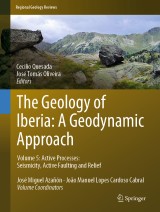Details

The Geology of Iberia: A Geodynamic Approach
Volume 5: Active Processes: Seismicity, Active Faulting and ReliefRegional Geology Reviews
|
139,09 € |
|
| Verlag: | Springer |
| Format: | |
| Veröffentl.: | 11.05.2019 |
| ISBN/EAN: | 9783030109318 |
| Sprache: | englisch |
Dieses eBook enthält ein Wasserzeichen.
Beschreibungen
<p>Adopting a global approach, this unique book provides an updated review of the geology of Iberia and its continental margins from a geodynamic perspective. Owing to its location close to successive plate margins, Iberia has played a pivotal role in the geodynamic evolution of the Gondwanan, Rheic, Pangea, Tethys and Eurasian plates over the last 600 Ma of Earth’s history. The geological record starts with the amalgamation of Gondwana in the Neoproterozoic, which was succeeded by the rifting and spreading of the Rheic ocean; its demise, which led to the amalgamation of Pangea in the late Paleozoic; and the rifting and spreading of several arms of the Neotethys ocean in the Mesozoic Era and their ongoing closure, which was responsible for the Alpine orogeny. The significant advances in the last 20 years have increasingly attracted international interest in exploring the geology of the Iberian Peninsula.</p>
<p>This final volume of the <i>Geology of Iberia</i> focuses on the active geological processes in Iberia including seismicity and active faulting as well as the modern landscapes in the Iberian Peninsula.</p><p></p><p></p><p></p>
<p>This final volume of the <i>Geology of Iberia</i> focuses on the active geological processes in Iberia including seismicity and active faulting as well as the modern landscapes in the Iberian Peninsula.</p><p></p><p></p><p></p>
<div>1. Preface.- 2.Active processes in Iberia: An Introduction.- 3.Active deformation in the Iberian Peninsula from geodetic techniques.- 4.Seismicity of the Iberian Peninsula.- 5. Active faults in Iberia.- 6. Active landscapes of Iberia.</div>
<div><p>Cecilio Quesada’s professional career was based at Instituto Geológico Minero de España (Spanish Geological Survey), until he retired from there in 2013. He is currently an Honorary Professor at the Faculty of Geological Sciences, Universidad Complutense, Madrid, where he also served temporarily as an Associate Professor. As a “survey person”, his research interests, past and present, include geological mapping, regional geology, tectonics and geochronology, mainly focused on the Variscan orogen in its global context. He has participated in ten IGCP projects since 1979, and is currently involved in Project 648: Supercontinent cycles & Global Geodynamics.</p>
<p>José Tomás Oliveira holds a Ph.D. and <i>Agregação</i> (Portuguese postdoctoral degree). He is a geologist and is currently collaborating at Laboratorio Nacional de Energia e Geologia, former Geological Survey of Portugal, where he acted also as Head of the Geology and Mineral Resources departments. As a survey geologist,<i> </i>his main activities have focused on regional geological mapping in Portugal and Mozambique, with a particular interest in stratigraphy, clastic sedimentology and basin analysis. He has been an Invited Professor at universities in Portugal and Angola, author and editor of several geological maps, and was co-editor of the recently published Geological Map of Portugal and Spain, 2015, scale 1:1,000,000.</p><br></div>
<p>José Tomás Oliveira holds a Ph.D. and <i>Agregação</i> (Portuguese postdoctoral degree). He is a geologist and is currently collaborating at Laboratorio Nacional de Energia e Geologia, former Geological Survey of Portugal, where he acted also as Head of the Geology and Mineral Resources departments. As a survey geologist,<i> </i>his main activities have focused on regional geological mapping in Portugal and Mozambique, with a particular interest in stratigraphy, clastic sedimentology and basin analysis. He has been an Invited Professor at universities in Portugal and Angola, author and editor of several geological maps, and was co-editor of the recently published Geological Map of Portugal and Spain, 2015, scale 1:1,000,000.</p><br></div>
<p></p><p>Adopting a global approach, this unique book provides an updated review of the geology of Iberia and its continental margins from a geodynamic perspective. Owing to its location close to successive plate margins, Iberia has played a pivotal role in the geodynamic evolution of the Gondwanan, Rheic, Pangea, Tethys and Eurasian plates over the last 600 Ma of Earth’s history. The geological record starts with the amalgamation of Gondwana in the Neoproterozoic, which was succeeded by the rifting and spreading of the Rheic ocean; its demise, which led to the amalgamation of Pangea in the late Paleozoic; and the rifting and spreading of several arms of the Neotethys ocean in the Mesozoic Era and their ongoing closure, which was responsible for the Alpine orogeny. The significant advances in the last 20 years have increasingly attracted international interest in exploring the geology of the Iberian Peninsula.</p><p> </p><p>This final volume of the <i>Geology of Iberia</i> focuses onthe active geological processes in Iberia including seismicity and active faulting as well as the modern landscapes in the Iberian Peninsula.</p><p></p>
Enriches readers’ understanding of the evolution of the Iberian microplate over the last 600 million years Reviews in detail key recent advances on the geology of the Iberian Peninsula from a geodynamic perspective Summarizes the latest studies on the record of the Cadomian, Variscan, and Alpine orogenies in Iberia Offers readers essential insights into the evolution of plate boundaries in the western corner of Europe

















